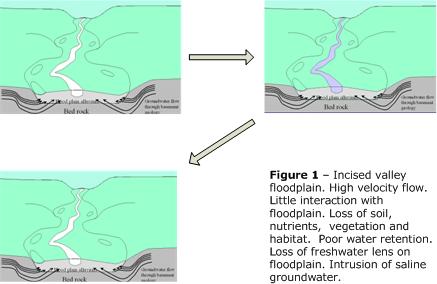Peter Andrews
Over 30 years ago Peter, bought a run-down 2000 acre grazing property called Tarwyn Park, near Bylong in the Upper Hunter Valley. He then quietly set about testing the theories that he had been developing virtually ever since he was a child, growing up on a station near Broken Hill. By 1976 Peter Andrews claimed that the model he had set up on Tarwyn Park was an example of a sustainable agricultural system. Peter had recognized that the incised nature of most streams in Australia was in fact accelerating the fertility decline of agricultural landscapes (Figure 1). Stream incision meant that the increasing erosive energy of water was leading to accelerated soil and nutrient loss, lowered capacity for the floodplain to hold water and a loss of wetland habitat within that valley. Stream incision had in fact lead to a total disruption of the natural fertility cycle, leading to a chronic decline the overall health of the landscape. He also observed that, under natural conditions, the interaction between fluvial and biological processes would combine to maximise the efficiency of nutrient and water use as well as carbon cycling. He argued that this would actually lead to a growing of that landscape as sedimentation would far exceed erosion and carbon sequestration would far exceed carbon loss (Figure 2).
The model that Peter Andrews set up at Tarwyn Park was based on the principle of reintroducing natural landscape patterns and processes as they would have existed in Australia prior to European settlement. This included:
Mr Andrews called his approach the Natural Farming Sequence. It has later become known as Natural Sequence Farming. |
 Peter Andrews is a grazier and
race horse breeder from Bylong in the Upper Hunter Valley. He
is a man who many believe is way ahead of his time. Peter has
gained fundamental insights to the natural functioning of the
Australian landscape that leave him almost without peer. He
has applied these insights in restoring his and other
properties to fertility levels that he says existed upon
European arrival in this country.
Peter Andrews is a grazier and
race horse breeder from Bylong in the Upper Hunter Valley. He
is a man who many believe is way ahead of his time. Peter has
gained fundamental insights to the natural functioning of the
Australian landscape that leave him almost without peer. He
has applied these insights in restoring his and other
properties to fertility levels that he says existed upon
European arrival in this country. 

 To test his theories
about improved animal health, he measured the growth and
performance of thoroughbred race horses.
To test his theories
about improved animal health, he measured the growth and
performance of thoroughbred race horses.